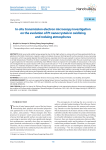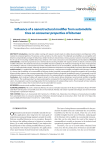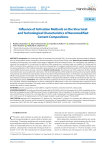Статьи журнала - Nanotechnologies in Construction: A Scientific Internet-Journal
Все статьи: 409

Статья научная
Metal nanocrystals exhibit unique properties due to their high surface-to-volume ratio and have great potential for applications in the fields of electronics, magnetics, optics and catalysis. However, their high specific surface area leads to easy coarsening in operation, which may greatly degrade their performances, especially when they are exposed to various chemical environments or at high temperatures. Therefore, the direct visualization of nanocrystals' structural evolution when they are coarsening is crucial to gain insight into the mechanism and develop more effective means to improve the size stability of nanocrystals. In this work, we investigated the structural evolution of Pt nanocrystals with sizes of ~ 4 nm on SiNx film in both oxidizing and reducing atmospheres at a moderate temperature (300оС) in the aberration-corrected environmental transmission electron microscopy (ETEM). The sizes of nanocrystals remain almost unchanged when annealed in the oxygen atmosphere with volatile PtOx formation on the surface, hindering nanocrystals sintering and leading to Pt loss. On the other hand, obvious coarsening of nanocrystals resulting from Ostwald-ripening and nanocrystal migration and coalescence was observed in the reducing atmosphere. Our findings reveal the dynamic structural evolution of nanocrystals in different atmospheres and provide possible ways to improve the size stability of nanocrystals.
Бесплатно

Influence of a nanostructural modifier from automobile tires on consumer properties of bitumen
Статья научная
Introduction. Used tire rubber cracking with organic solvents leads to rubber devulcanization and dispersion of the material to nanosized particles. The process can be carried out in a flow reactor. The obtained nanomodifiers are compatible with bitumen and predictably change the bituminous binder technical characteristics. Various practical solutions have been proposed for the use of the resulting modified bituminous binders in the road construction and strengthening soil foundations. Methods and materials. It has been proposed to use a method of joint cracking of rubber with organic solvents to obtain a nanostructured modifier of bitumen. The obtained nanostructural modifier has been studied by the methods of analyzing the sizes of nanoparticles and solubility in toluene. For the bituminous binders obtained with the use of nanomodifiers, standard characteristics for bitumen, such as needle penetration depth, softening temperature, brittleness temperature and extensibility have been determined. Results and discussion. It is established that during the proposed process, a nanostructural modifier compatible with bitumen is formed. It is shown that the addition of a nanomodifier to bitumen makes it possible to purposefully change the properties of the resulting bitumen binder, improve the consumer properties of the bitumen binder and expand its application areas. It is proposed to use the obtained product as a component of waterproofing mastics for waterproofing the underground parts of buildings and structures. Conclusion. Joint cracking of rubber with organic solvents in a flow reactor allows obtaining a nanostructural modifier compatible with bitumen. The resulting product has improved properties compared to the original bitumen, which expands its scope of application. It is proposed to use the resulting product for the manufacture of waterproofing mastics. The proposed technical solutions make it possible to reduce the environmental load of automobile tires wastes.
Бесплатно

Статья научная
Introduction. We studied the effect of nanosized silicon dioxide (SiO2) on the structural and technological characteristics of nanomodified cement compositions introduced together with activated mixing water. Materials and research methods. Activation of mixing water was carried out by means of magnetic field and ultrasonic action. For investigation the capability to maintain their properties for a long time, the stability of silica suspensions in activated water was studied. For finding out the effect of activated silica suspensions on the structure and properties of composite materials based on cement, the physical and mechanical properties of the studied compositions were explored. X-ray and differential thermal analysis of the hardened activated nanomodified cement paste were also carried out. Results and discussion. The positive role of the suspension of silicon dioxide in activated water was associated with a decrease in the microheterogeneity of the hardened cement paste, ensuring the stability of its physical and mechanical characteristics. Based on the above mentioned observations, a mechanism was proposed for more efficient incorporation of nanosized silicon dioxide into cement hydration processes both due to chemisorption with Ca(OH)2 in the hardening cement paste and due to the topological effect of nanoparticle localization in defects and ultramicrovoids of a crystallizing disperse system. Conclusion. The results show that suspensions of silica in activated water can maintain their properties for a long time. Graphical dependencies are shown, indicating the effectiveness of the use of activated silica suspensions in the production of cement composites. This quality makes it possible to obtain repair compounds with the required properties during construction work for various purposes.
Бесплатно


















